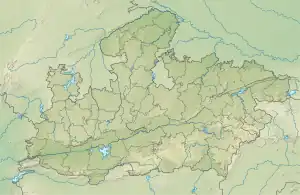| Tiki Formation | |
|---|---|
| Stratigraphic range: Carnian-Norian ~ | |
| Type | Geological formation |
| Unit of | Gondwana Group |
| Sub-units | Lower & Upper members |
| Lithology | |
| Primary | Mudstone |
| Other | Claystone, sandstone |
| Location | |
| Coordinates | 23°54′N 81°24′E / 23.9°N 81.4°E |
| Approximate paleocoordinates | 42°36′S 51°06′E / 42.6°S 51.1°E |
| Region | Madhya Pradesh |
| Country | |
| Type section | |
| Named for | Tiki village |
 Tiki Formation (India)  Tiki Formation (Madhya Pradesh) | |
The Tiki Formation is a Late Triassic (Carnian to Norian) geologic formation in Madhya Pradesh, northern India.[1] Dinosaur remains are among the fossils that have been recovered from the formation, although none have yet been referred to a specific genus.[2] Phytosaur remains attributable to the genus Volcanosuchus have also been found in the Tiki Formation.[3]
The genera Tikiodon, Tikitherium and Tikisuchus and species Rewaconodon tikiensis, Hyperodapedon tikiensis and Parvodus tikiensis have been named after the Tiki Formation.
Fossil content
The following fossils have been described from the formation:[1]
Cynodonts
| Cynodonts of the Tiki Formation | |||
|---|---|---|---|
| Genus | Species | Material | Notes |
| Gondwanadon[4][5] | G. tapani | A single molar | A morganucodont |
| Inditherium[4] | I. floris | Three postcanine teeth | A dromatheriid |
| Rewaconodon[4] | R. indicus | A partial jaw and three postcanine teeth | A dromatheriid |
| R. tikiensis[6] | |||
| Ruberodon[4][7] | R. roychowdhurii | Five partial jaws | A traversodontid |
| Tikiodon[4] | T. cromptoni | A single postcanine tooth | A mammaliamorph |
| Tikitherium[4][8] | T. copei | A single molar | A mammaliaform related to Docodonta |
| Cynodontia indet. | |||
Other fossils
Reptiles
Amphibians
Fish
Flora
- Baiera sp.[15]
- Dicroidium sp.[15]
- Elatocladus sp.[15]
- Lepidopteris sp.[15]
- Pagiophyllum sp.[15]
- Sphenobaiera sp.[15]
- Xylopteris sp.[15]
- Yabeiella sp.[15]
Correlations
The Tiki Formation is considered a temporal equivalent of the Lower Maleri Formation. The majority of the Tiki Formation correlates with the Ischigualasto Formation of Argentina, the upper part of the Santa Maria Formation, and the overlying lower Caturrita Formation of Brazil, the Isalo II Beds of Madagascar, Lossiemouth Sandstone of Scotland, and the lower Tecovas Formation of the Chinle Group of North America.[1]
See also
References
- 1 2 3 Tiki Formation at Fossilworks.org
- ↑ Weishampel et al., 2004, "Dinosaur distribution", pp. 517-607
- 1 2 Chatterjee, 1978
- 1 2 3 4 5 6 Bhat, M. S.; Ray, S.; Datta, P. M. (2020). "New cynodonts (Therapsida, Eucynodontia) from the Late Triassic of India and their significances". Journal of Paleontology. 95 (2): 376–393. doi:10.1017/jpa.2020.95. S2CID 228836405.
- ↑ Datta & Das, 1996
- 1 2 3 4 5 6 7 8 9 10 11 Kumar & Sharma, 2019
- ↑ Ray, S. (2015). "A new Late Triassic traversodontid cynodont (Therapsida, Eucynodontia) from India". Journal of Vertebrate Paleontology. 35 (3): e930472. doi:10.1080/02724634.2014.930472. S2CID 86368800.
- ↑ Datta, P. M. (2005). "Earliest mammal with transversely expanded upper molar from the Late Triassic (Carnian) Tiki Formation, South Rewa Gondwana Basin, India". Journal of Vertebrate Paleontology. 25 (1): 200–207. doi:10.1671/0272-4634(2005)025[0200:EMWTEU]2.0.CO;2.
- ↑ Lydekker, 1885
- ↑ Mukherjee & Ray, 2015
- 1 2 3 4 Chatterjee & Majumdar, 1987
- 1 2 3 Datta et al., 2005
- ↑ Mukherjee & Ray, 2012
- ↑ Huene, 1940
- 1 2 3 4 5 6 7 8 Pal, 1984
Bibliography
- Kumar, J., and K. M. Sharma. 2019. Micro and mega-vertebrate fossils from the Late Triassic Tiki Formation, South Rewa Gondwana Basin, India: palaeoenvironmental and palaeobiogeographic implications. Journal of the Palaeontological Society of India 64. 151–168. .
- Mukherjee, D., and S. Ray. 2015. A new Hyperodapedon (Archosauromorpha, Rhynchosauria) from the upper Triassic of India: implications for rhynchosaur phylogeny. Palaeontology 57. 1241–1276. .
- Mukherjee, D., and S. Ray. 2012. Taphonomy of an Upper Triassic vertebrate bonebed: A new rhynchosaur (Reptilia; Archosauromorpha) accumulation from India. Palaeogeography, Palaeoclimatology, Palaeoecology 333-334. 75–91. .
- Datta, P. M.; D. P. Das, and Z.-X. Luo. 2004. A late Triassic dromatheriid (Synapsida: Cynodontia) from India. Annals of Carnegie Museum 73. 72–84. .
- Weishampel, David B.; Peter Dodson, and Halszka Osmólska (eds.). 2004. The Dinosauria, 2nd edition, 1–880. Berkeley: University of California Press. Accessed 2019-02-21. ISBN 0-520-24209-2
- Datta, P. M., and D. P. Das. 1996. Discovery of the oldest fossil mammal from India. Indian Minerals 50. 217–222. .
- Chatterjee, S., and P. K. Majumdar. 1987. Tikisuchus romeri, a new rauisuchid reptile from the Late Triassic of India. Journal of Paleontology 61. 787–793. .
- Pal, P.K. 1984. Triassic plant megafossils from the Tiki Formation, South Rewa Gondwana Basin, India. The Palaeobotanist 32. 253-309. .
- Chatterjee, S. 1978. A primitive parasuchid (Phytosaur) reptile from the Upper Triassic Maleri Formation of India. Palaeontology 21. 83–127. .
- Huene, F. von. 1940. The tetrapod fauna of the Upper Triassic Maleri Beds. Memoirs of the Geological Survey of India Palaeontologia Indica 32. 1–42. .
- Lydekker, R. 1885. The Reptilia & Amphibia of the Maleria & Denwa Groups. Memoirs of the Geological Survey of India. Palaeontologia Indica, Series IV. Indian Pretertiary Vertebrata 1. 1–38. .